Financial Analysis Report: Aristocrat Leisure Limited (FINC300)
VerifiedAdded on 2023/06/07
|22
|4241
|139
Report
AI Summary
This report presents a detailed financial analysis of Aristocrat Leisure Limited (ALL), a leading global manufacturer of gambling machines. It begins with an introduction to the company, its operations, and its diverse product offerings, followed by a shareholder analysis categorizing investors and their investment philosophies. The report then assesses ALL's current market position, types of returns, and risk-return profile, including shareholder returns for FY2017 and business risks such as economic conditions, competition, and government regulations. Cost of capital is computed using the CAPM and Dividend Growth Model, with a WACC calculation, and the report concludes with a financial statement analysis, including market value-based measures, profitability ratios, and a DuPont analysis to assess ALL's financial health and performance.
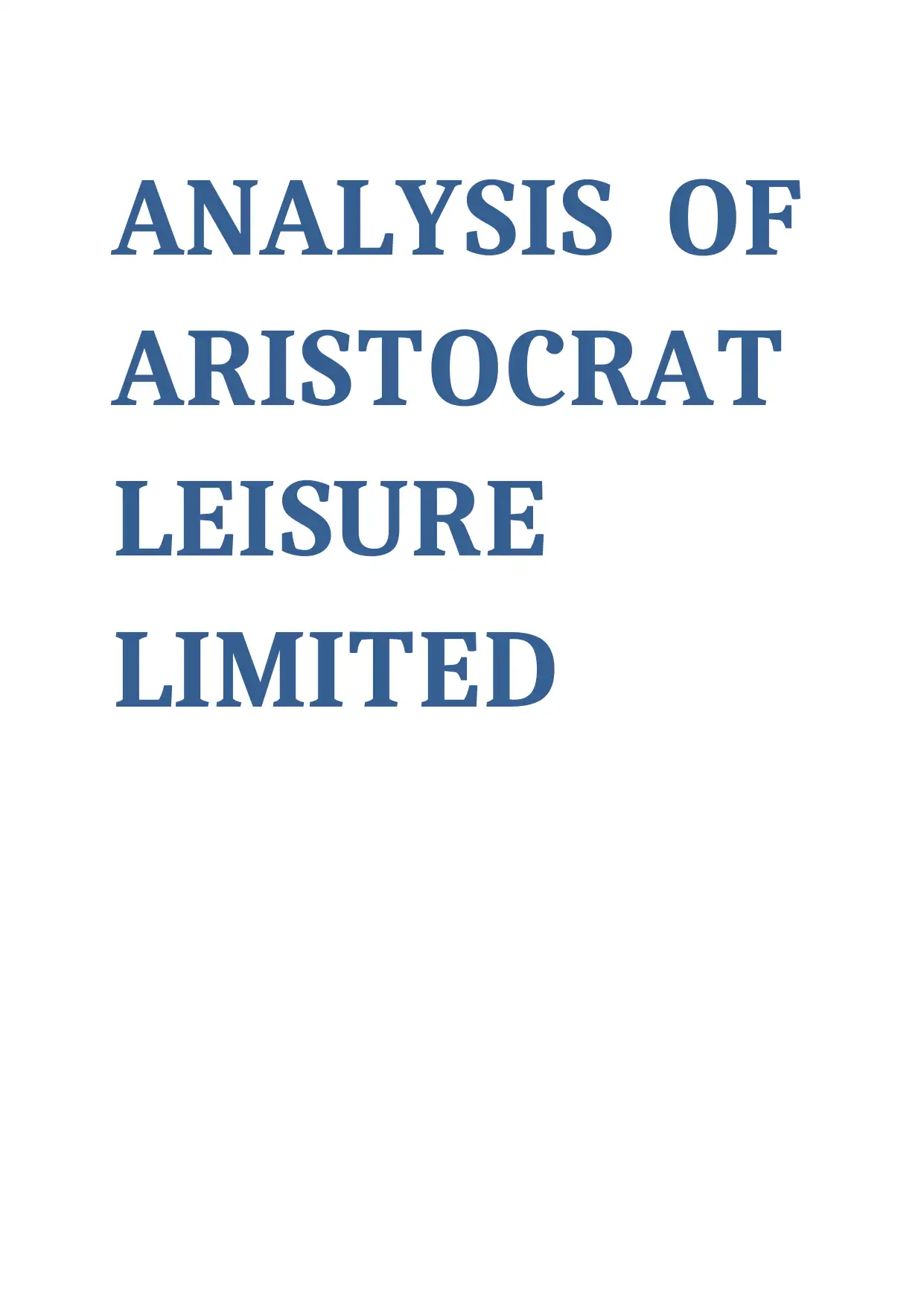
ANALYSIS OF
ARISTOCRAT
LEISURE
LIMITED
ARISTOCRAT
LEISURE
LIMITED
Paraphrase This Document
Need a fresh take? Get an instant paraphrase of this document with our AI Paraphraser
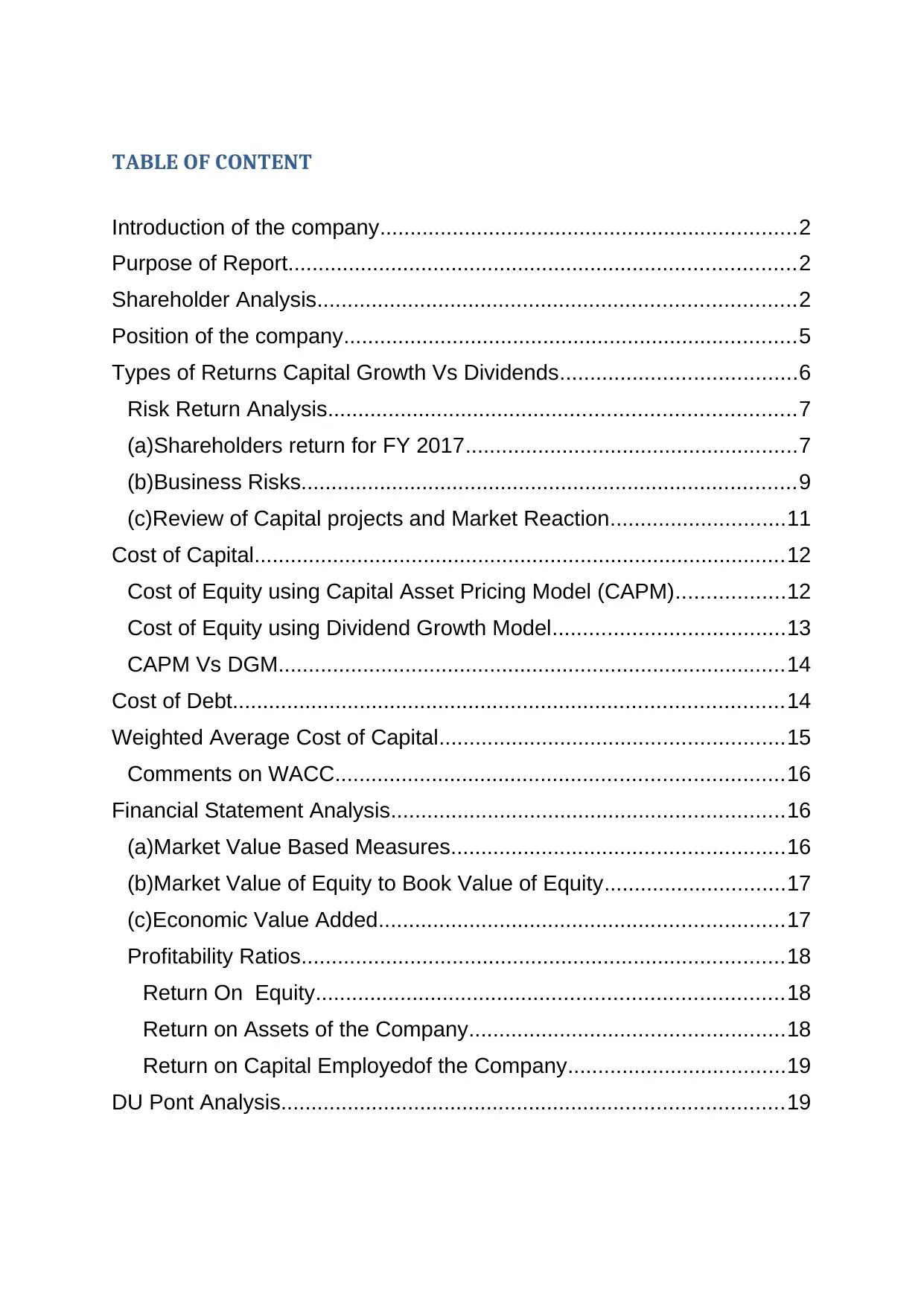
TABLE OF CONTENT
Introduction of the company.....................................................................2
Purpose of Report....................................................................................2
Shareholder Analysis...............................................................................2
Position of the company...........................................................................5
Types of Returns Capital Growth Vs Dividends.......................................6
Risk Return Analysis.............................................................................7
(a)Shareholders return for FY 2017.......................................................7
(b)Business Risks..................................................................................9
(c)Review of Capital projects and Market Reaction.............................11
Cost of Capital........................................................................................12
Cost of Equity using Capital Asset Pricing Model (CAPM)..................12
Cost of Equity using Dividend Growth Model......................................13
CAPM Vs DGM....................................................................................14
Cost of Debt...........................................................................................14
Weighted Average Cost of Capital.........................................................15
Comments on WACC..........................................................................16
Financial Statement Analysis.................................................................16
(a)Market Value Based Measures.......................................................16
(b)Market Value of Equity to Book Value of Equity..............................17
(c)Economic Value Added...................................................................17
Profitability Ratios................................................................................18
Return On Equity.............................................................................18
Return on Assets of the Company....................................................18
Return on Capital Employedof the Company....................................19
DU Pont Analysis...................................................................................19
Introduction of the company.....................................................................2
Purpose of Report....................................................................................2
Shareholder Analysis...............................................................................2
Position of the company...........................................................................5
Types of Returns Capital Growth Vs Dividends.......................................6
Risk Return Analysis.............................................................................7
(a)Shareholders return for FY 2017.......................................................7
(b)Business Risks..................................................................................9
(c)Review of Capital projects and Market Reaction.............................11
Cost of Capital........................................................................................12
Cost of Equity using Capital Asset Pricing Model (CAPM)..................12
Cost of Equity using Dividend Growth Model......................................13
CAPM Vs DGM....................................................................................14
Cost of Debt...........................................................................................14
Weighted Average Cost of Capital.........................................................15
Comments on WACC..........................................................................16
Financial Statement Analysis.................................................................16
(a)Market Value Based Measures.......................................................16
(b)Market Value of Equity to Book Value of Equity..............................17
(c)Economic Value Added...................................................................17
Profitability Ratios................................................................................18
Return On Equity.............................................................................18
Return on Assets of the Company....................................................18
Return on Capital Employedof the Company....................................19
DU Pont Analysis...................................................................................19
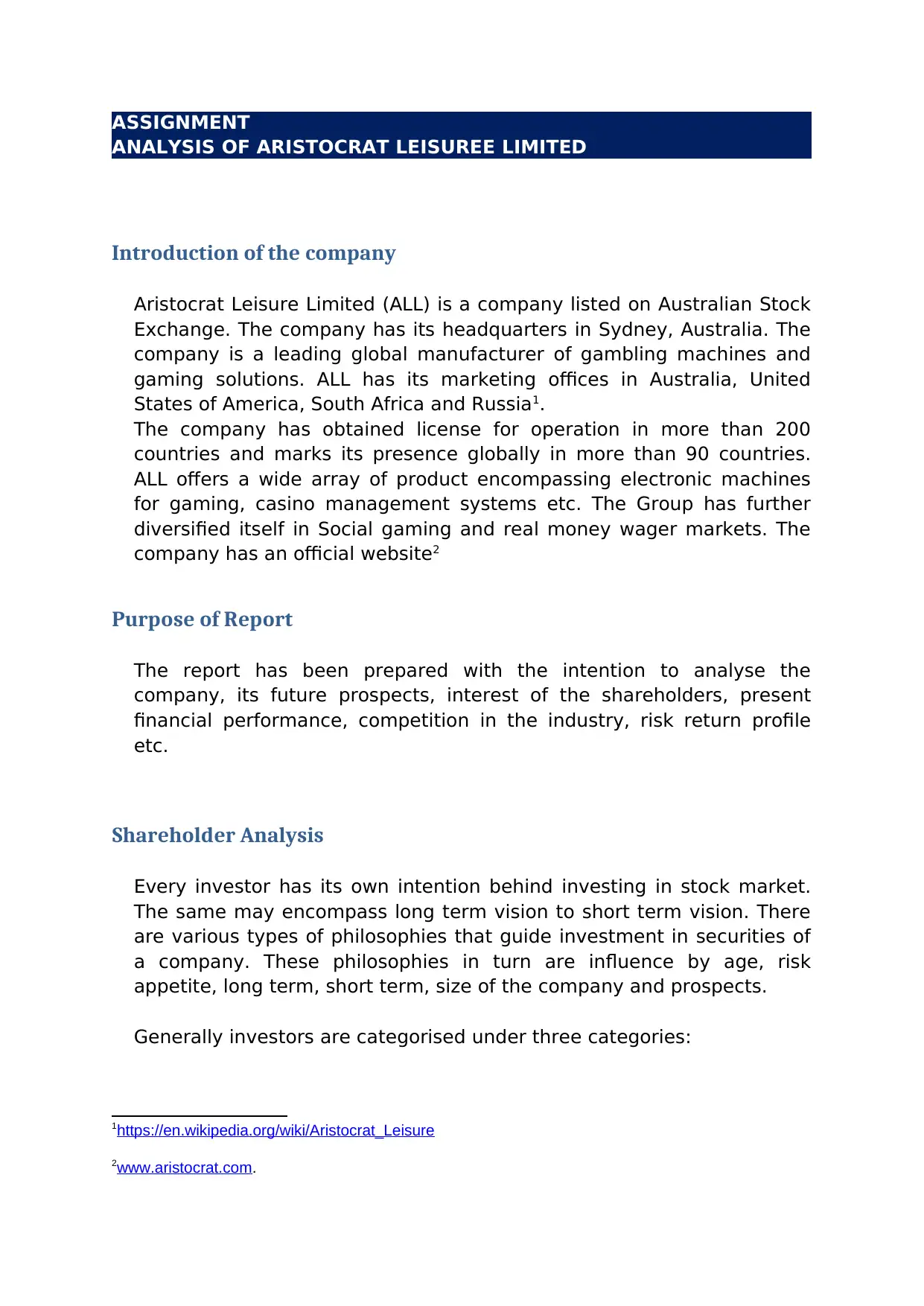
ASSIGNMENT
ANALYSIS OF ARISTOCRAT LEISUREE LIMITED
Introduction of the company
Aristocrat Leisure Limited (ALL) is a company listed on Australian Stock
Exchange. The company has its headquarters in Sydney, Australia. The
company is a leading global manufacturer of gambling machines and
gaming solutions. ALL has its marketing offices in Australia, United
States of America, South Africa and Russia1.
The company has obtained license for operation in more than 200
countries and marks its presence globally in more than 90 countries.
ALL offers a wide array of product encompassing electronic machines
for gaming, casino management systems etc. The Group has further
diversified itself in Social gaming and real money wager markets. The
company has an official website2
Purpose of Report
The report has been prepared with the intention to analyse the
company, its future prospects, interest of the shareholders, present
financial performance, competition in the industry, risk return profile
etc.
Shareholder Analysis
Every investor has its own intention behind investing in stock market.
The same may encompass long term vision to short term vision. There
are various types of philosophies that guide investment in securities of
a company. These philosophies in turn are influence by age, risk
appetite, long term, short term, size of the company and prospects.
Generally investors are categorised under three categories:
1https://en.wikipedia.org/wiki/Aristocrat_Leisure
2www.aristocrat.com.
ANALYSIS OF ARISTOCRAT LEISUREE LIMITED
Introduction of the company
Aristocrat Leisure Limited (ALL) is a company listed on Australian Stock
Exchange. The company has its headquarters in Sydney, Australia. The
company is a leading global manufacturer of gambling machines and
gaming solutions. ALL has its marketing offices in Australia, United
States of America, South Africa and Russia1.
The company has obtained license for operation in more than 200
countries and marks its presence globally in more than 90 countries.
ALL offers a wide array of product encompassing electronic machines
for gaming, casino management systems etc. The Group has further
diversified itself in Social gaming and real money wager markets. The
company has an official website2
Purpose of Report
The report has been prepared with the intention to analyse the
company, its future prospects, interest of the shareholders, present
financial performance, competition in the industry, risk return profile
etc.
Shareholder Analysis
Every investor has its own intention behind investing in stock market.
The same may encompass long term vision to short term vision. There
are various types of philosophies that guide investment in securities of
a company. These philosophies in turn are influence by age, risk
appetite, long term, short term, size of the company and prospects.
Generally investors are categorised under three categories:
1https://en.wikipedia.org/wiki/Aristocrat_Leisure
2www.aristocrat.com.
⊘ This is a preview!⊘
Do you want full access?
Subscribe today to unlock all pages.

Trusted by 1+ million students worldwide
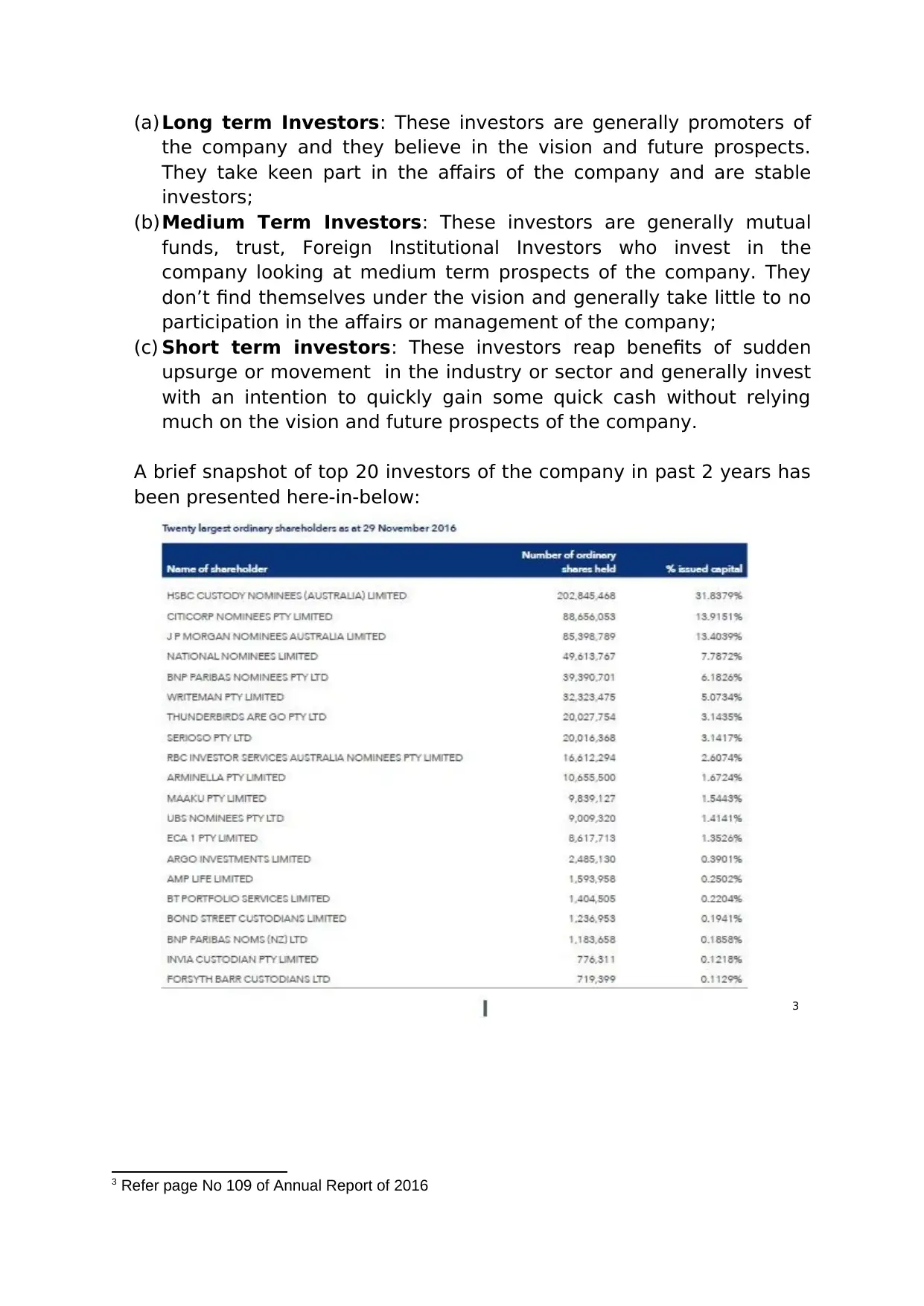
(a) Long term Investors: These investors are generally promoters of
the company and they believe in the vision and future prospects.
They take keen part in the affairs of the company and are stable
investors;
(b)Medium Term Investors: These investors are generally mutual
funds, trust, Foreign Institutional Investors who invest in the
company looking at medium term prospects of the company. They
don’t find themselves under the vision and generally take little to no
participation in the affairs or management of the company;
(c) Short term investors: These investors reap benefits of sudden
upsurge or movement in the industry or sector and generally invest
with an intention to quickly gain some quick cash without relying
much on the vision and future prospects of the company.
A brief snapshot of top 20 investors of the company in past 2 years has
been presented here-in-below:
3
3 Refer page No 109 of Annual Report of 2016
the company and they believe in the vision and future prospects.
They take keen part in the affairs of the company and are stable
investors;
(b)Medium Term Investors: These investors are generally mutual
funds, trust, Foreign Institutional Investors who invest in the
company looking at medium term prospects of the company. They
don’t find themselves under the vision and generally take little to no
participation in the affairs or management of the company;
(c) Short term investors: These investors reap benefits of sudden
upsurge or movement in the industry or sector and generally invest
with an intention to quickly gain some quick cash without relying
much on the vision and future prospects of the company.
A brief snapshot of top 20 investors of the company in past 2 years has
been presented here-in-below:
3
3 Refer page No 109 of Annual Report of 2016
Paraphrase This Document
Need a fresh take? Get an instant paraphrase of this document with our AI Paraphraser

4
On perusal of the above, it may be seen that majority shareholder of
the company are institutional investor that comprise of nominees and
bank that hold a large number of share who buy and sell their stake
under short term to medium term to reap the benefits of escalation in
prices of the shares of the company. 70% and more of the shares of the
company are held by banks and nominees which are opportunistic and
liquidate their holdings for a bargain. Thus, they can be categorised as
marginal investors.
Further, there are certain companies who hold less than 10% of the
companies but have place reliance on the financial and strength of the
company. These include:
(a) ECA 1 Pty Ltd;
(b)Amp Life Limited;
(c) Maaku Pty Limited.
These aforesaid companies have been trying to increase their
shareholding in the company by relying on the vision prospects of the
company and may be classified as long term investors of the company.
4 Refer Page no 111 of Annual Report 2017
On perusal of the above, it may be seen that majority shareholder of
the company are institutional investor that comprise of nominees and
bank that hold a large number of share who buy and sell their stake
under short term to medium term to reap the benefits of escalation in
prices of the shares of the company. 70% and more of the shares of the
company are held by banks and nominees which are opportunistic and
liquidate their holdings for a bargain. Thus, they can be categorised as
marginal investors.
Further, there are certain companies who hold less than 10% of the
companies but have place reliance on the financial and strength of the
company. These include:
(a) ECA 1 Pty Ltd;
(b)Amp Life Limited;
(c) Maaku Pty Limited.
These aforesaid companies have been trying to increase their
shareholding in the company by relying on the vision prospects of the
company and may be classified as long term investors of the company.
4 Refer Page no 111 of Annual Report 2017

Further Len Ainsworth who holds a substantial holding in the company
through custodian and other means is the promoter of the company and
is associated with the long term vision of the company.
Position of the company
Further, the current position of the company has been tabulated here-
in-below:
Sl No Particulars Amount
1 Market Capitalisation 19.297 Billion
2 Beta 1.06
3 PE Ratio 38.45
4 EPS 0.79
5 Future Target Estimated 34.63
6 Current Price 30.22
Screener with Industry and sector Analysis
Growth Screener
through custodian and other means is the promoter of the company and
is associated with the long term vision of the company.
Position of the company
Further, the current position of the company has been tabulated here-
in-below:
Sl No Particulars Amount
1 Market Capitalisation 19.297 Billion
2 Beta 1.06
3 PE Ratio 38.45
4 EPS 0.79
5 Future Target Estimated 34.63
6 Current Price 30.22
Screener with Industry and sector Analysis
Growth Screener
⊘ This is a preview!⊘
Do you want full access?
Subscribe today to unlock all pages.

Trusted by 1+ million students worldwide
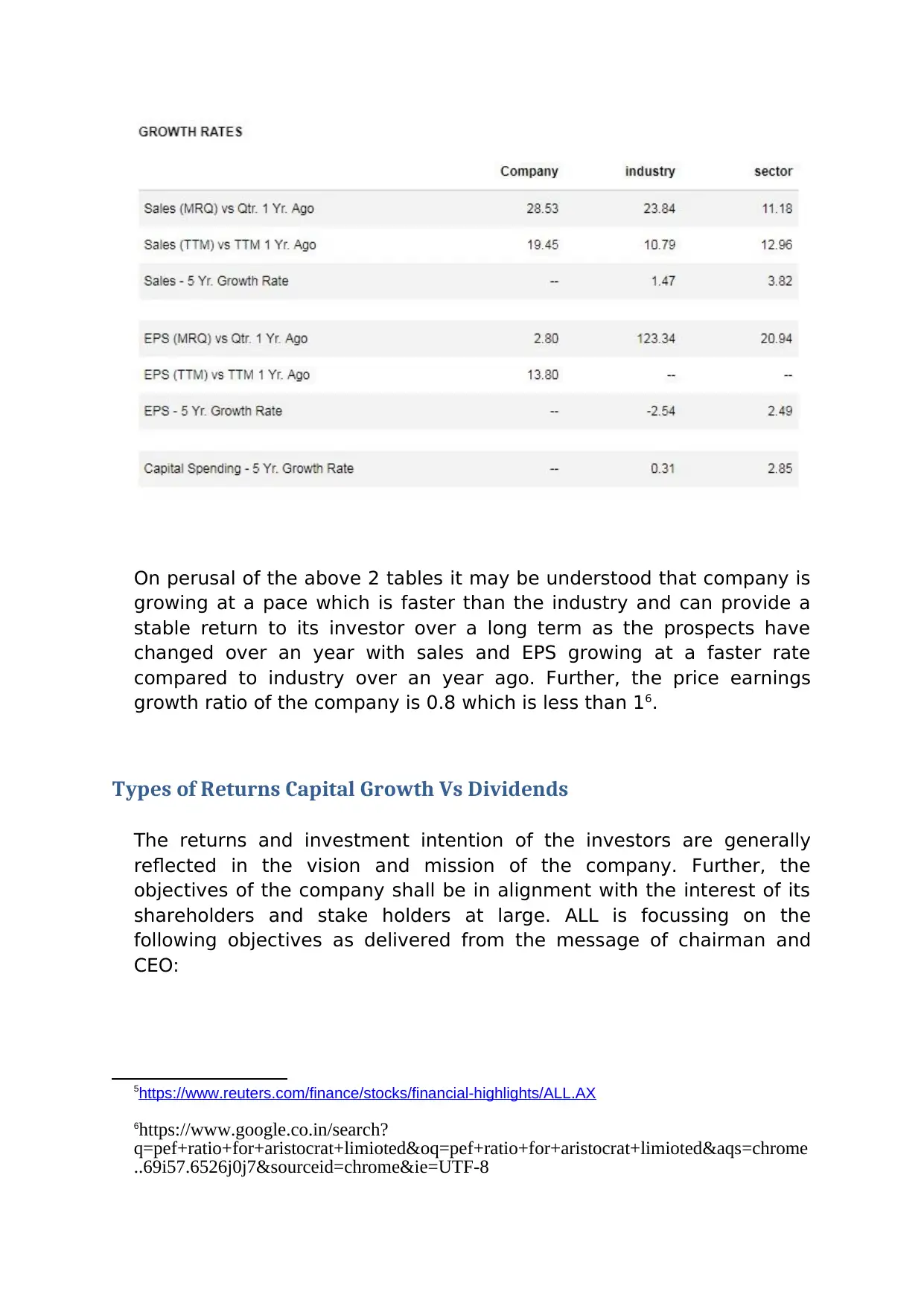
On perusal of the above 2 tables it may be understood that company is
growing at a pace which is faster than the industry and can provide a
stable return to its investor over a long term as the prospects have
changed over an year with sales and EPS growing at a faster rate
compared to industry over an year ago. Further, the price earnings
growth ratio of the company is 0.8 which is less than 16.
Types of Returns Capital Growth Vs Dividends
The returns and investment intention of the investors are generally
reflected in the vision and mission of the company. Further, the
objectives of the company shall be in alignment with the interest of its
shareholders and stake holders at large. ALL is focussing on the
following objectives as delivered from the message of chairman and
CEO:
5https://www.reuters.com/finance/stocks/financial-highlights/ALL.AX
6https://www.google.co.in/search?
q=pef+ratio+for+aristocrat+limioted&oq=pef+ratio+for+aristocrat+limioted&aqs=chrome
..69i57.6526j0j7&sourceid=chrome&ie=UTF-8
growing at a pace which is faster than the industry and can provide a
stable return to its investor over a long term as the prospects have
changed over an year with sales and EPS growing at a faster rate
compared to industry over an year ago. Further, the price earnings
growth ratio of the company is 0.8 which is less than 16.
Types of Returns Capital Growth Vs Dividends
The returns and investment intention of the investors are generally
reflected in the vision and mission of the company. Further, the
objectives of the company shall be in alignment with the interest of its
shareholders and stake holders at large. ALL is focussing on the
following objectives as delivered from the message of chairman and
CEO:
5https://www.reuters.com/finance/stocks/financial-highlights/ALL.AX
6https://www.google.co.in/search?
q=pef+ratio+for+aristocrat+limioted&oq=pef+ratio+for+aristocrat+limioted&aqs=chrome
..69i57.6526j0j7&sourceid=chrome&ie=UTF-8
Paraphrase This Document
Need a fresh take? Get an instant paraphrase of this document with our AI Paraphraser
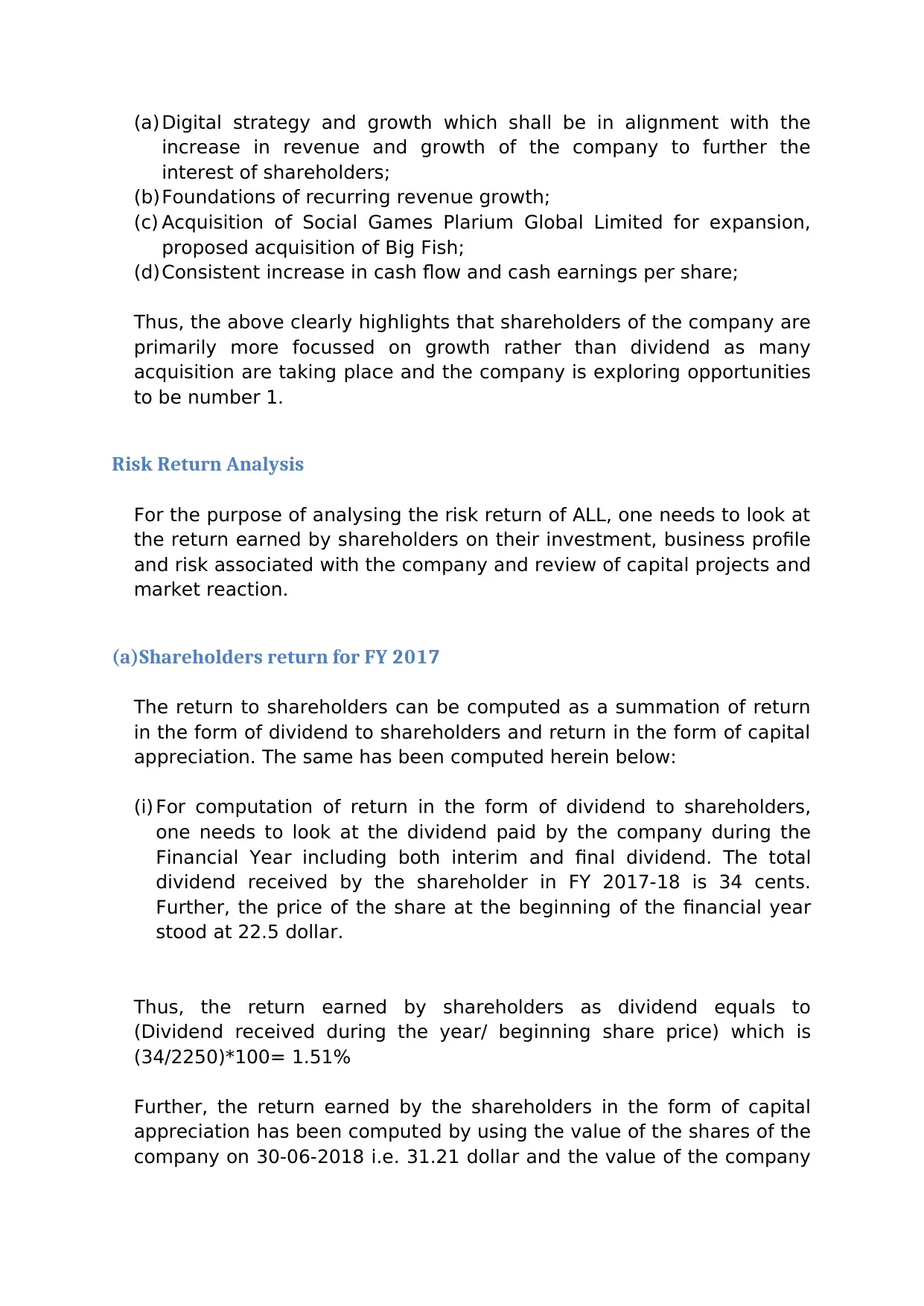
(a) Digital strategy and growth which shall be in alignment with the
increase in revenue and growth of the company to further the
interest of shareholders;
(b)Foundations of recurring revenue growth;
(c) Acquisition of Social Games Plarium Global Limited for expansion,
proposed acquisition of Big Fish;
(d)Consistent increase in cash flow and cash earnings per share;
Thus, the above clearly highlights that shareholders of the company are
primarily more focussed on growth rather than dividend as many
acquisition are taking place and the company is exploring opportunities
to be number 1.
Risk Return Analysis
For the purpose of analysing the risk return of ALL, one needs to look at
the return earned by shareholders on their investment, business profile
and risk associated with the company and review of capital projects and
market reaction.
(a)Shareholders return for FY 2017
The return to shareholders can be computed as a summation of return
in the form of dividend to shareholders and return in the form of capital
appreciation. The same has been computed herein below:
(i) For computation of return in the form of dividend to shareholders,
one needs to look at the dividend paid by the company during the
Financial Year including both interim and final dividend. The total
dividend received by the shareholder in FY 2017-18 is 34 cents.
Further, the price of the share at the beginning of the financial year
stood at 22.5 dollar.
Thus, the return earned by shareholders as dividend equals to
(Dividend received during the year/ beginning share price) which is
(34/2250)*100= 1.51%
Further, the return earned by the shareholders in the form of capital
appreciation has been computed by using the value of the shares of the
company on 30-06-2018 i.e. 31.21 dollar and the value of the company
increase in revenue and growth of the company to further the
interest of shareholders;
(b)Foundations of recurring revenue growth;
(c) Acquisition of Social Games Plarium Global Limited for expansion,
proposed acquisition of Big Fish;
(d)Consistent increase in cash flow and cash earnings per share;
Thus, the above clearly highlights that shareholders of the company are
primarily more focussed on growth rather than dividend as many
acquisition are taking place and the company is exploring opportunities
to be number 1.
Risk Return Analysis
For the purpose of analysing the risk return of ALL, one needs to look at
the return earned by shareholders on their investment, business profile
and risk associated with the company and review of capital projects and
market reaction.
(a)Shareholders return for FY 2017
The return to shareholders can be computed as a summation of return
in the form of dividend to shareholders and return in the form of capital
appreciation. The same has been computed herein below:
(i) For computation of return in the form of dividend to shareholders,
one needs to look at the dividend paid by the company during the
Financial Year including both interim and final dividend. The total
dividend received by the shareholder in FY 2017-18 is 34 cents.
Further, the price of the share at the beginning of the financial year
stood at 22.5 dollar.
Thus, the return earned by shareholders as dividend equals to
(Dividend received during the year/ beginning share price) which is
(34/2250)*100= 1.51%
Further, the return earned by the shareholders in the form of capital
appreciation has been computed by using the value of the shares of the
company on 30-06-2018 i.e. 31.21 dollar and the value of the company
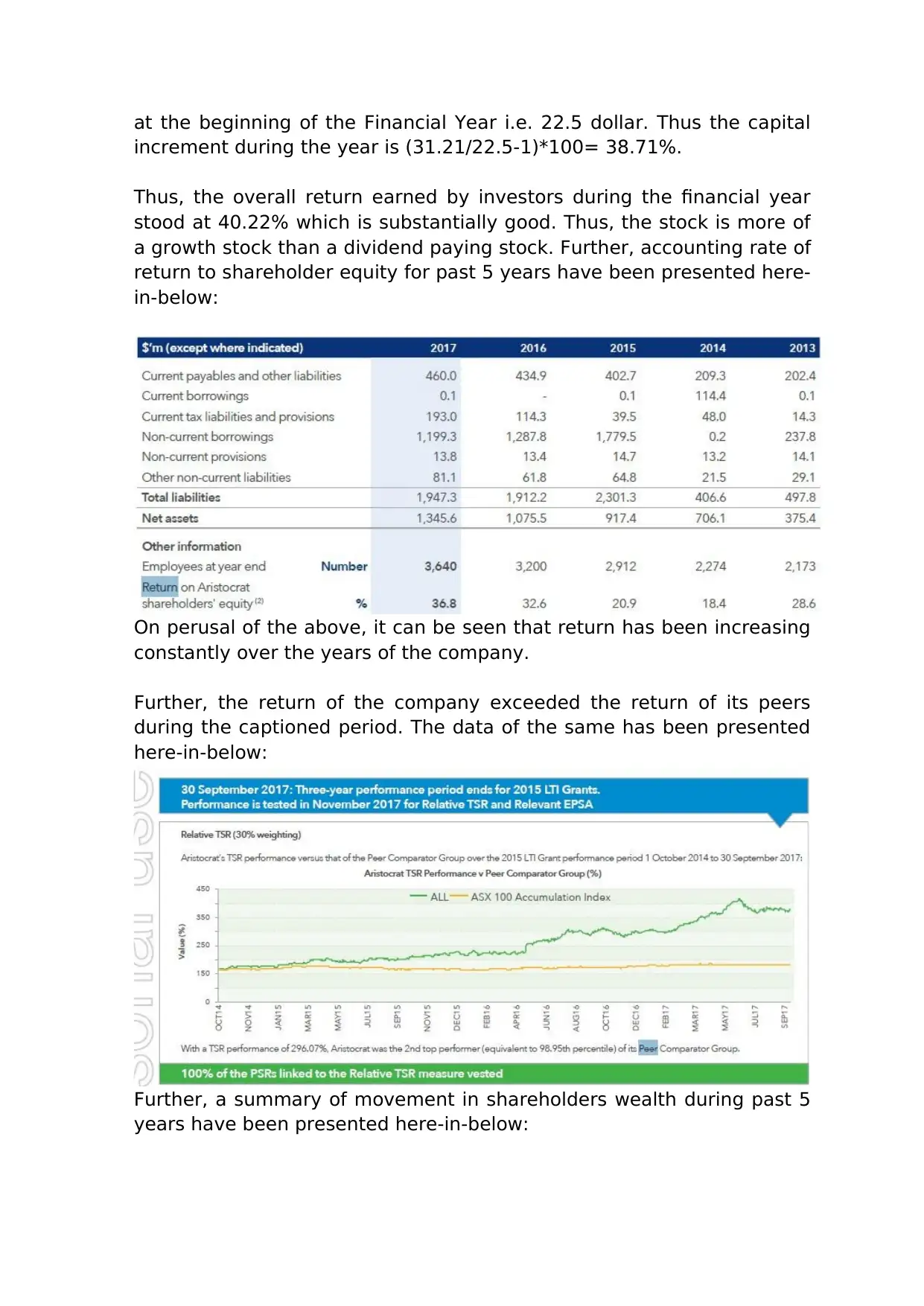
at the beginning of the Financial Year i.e. 22.5 dollar. Thus the capital
increment during the year is (31.21/22.5-1)*100= 38.71%.
Thus, the overall return earned by investors during the financial year
stood at 40.22% which is substantially good. Thus, the stock is more of
a growth stock than a dividend paying stock. Further, accounting rate of
return to shareholder equity for past 5 years have been presented here-
in-below:
On perusal of the above, it can be seen that return has been increasing
constantly over the years of the company.
Further, the return of the company exceeded the return of its peers
during the captioned period. The data of the same has been presented
here-in-below:
Further, a summary of movement in shareholders wealth during past 5
years have been presented here-in-below:
increment during the year is (31.21/22.5-1)*100= 38.71%.
Thus, the overall return earned by investors during the financial year
stood at 40.22% which is substantially good. Thus, the stock is more of
a growth stock than a dividend paying stock. Further, accounting rate of
return to shareholder equity for past 5 years have been presented here-
in-below:
On perusal of the above, it can be seen that return has been increasing
constantly over the years of the company.
Further, the return of the company exceeded the return of its peers
during the captioned period. The data of the same has been presented
here-in-below:
Further, a summary of movement in shareholders wealth during past 5
years have been presented here-in-below:
⊘ This is a preview!⊘
Do you want full access?
Subscribe today to unlock all pages.

Trusted by 1+ million students worldwide
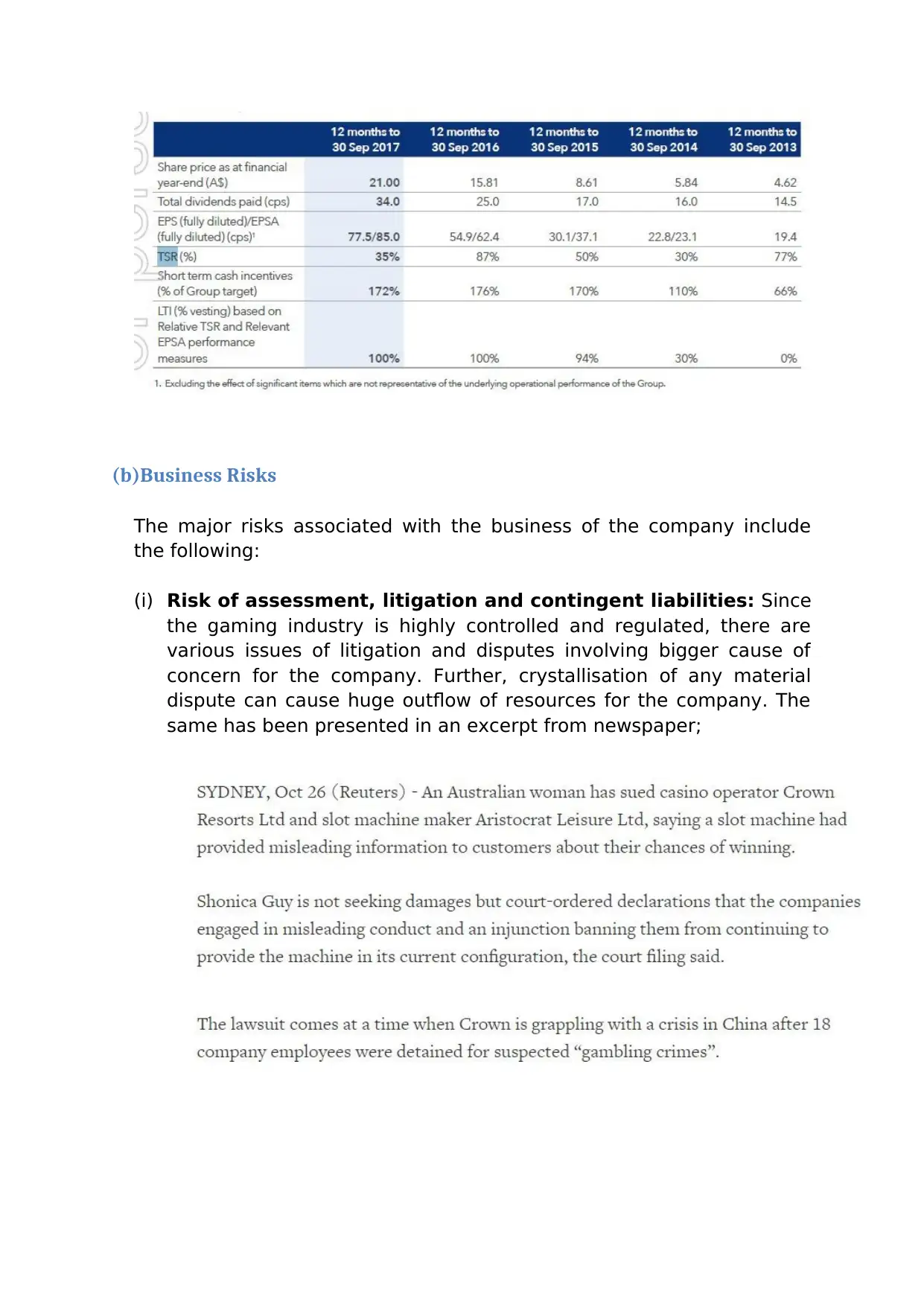
(b)Business Risks
The major risks associated with the business of the company include
the following:
(i) Risk of assessment, litigation and contingent liabilities: Since
the gaming industry is highly controlled and regulated, there are
various issues of litigation and disputes involving bigger cause of
concern for the company. Further, crystallisation of any material
dispute can cause huge outflow of resources for the company. The
same has been presented in an excerpt from newspaper;
The major risks associated with the business of the company include
the following:
(i) Risk of assessment, litigation and contingent liabilities: Since
the gaming industry is highly controlled and regulated, there are
various issues of litigation and disputes involving bigger cause of
concern for the company. Further, crystallisation of any material
dispute can cause huge outflow of resources for the company. The
same has been presented in an excerpt from newspaper;
Paraphrase This Document
Need a fresh take? Get an instant paraphrase of this document with our AI Paraphraser
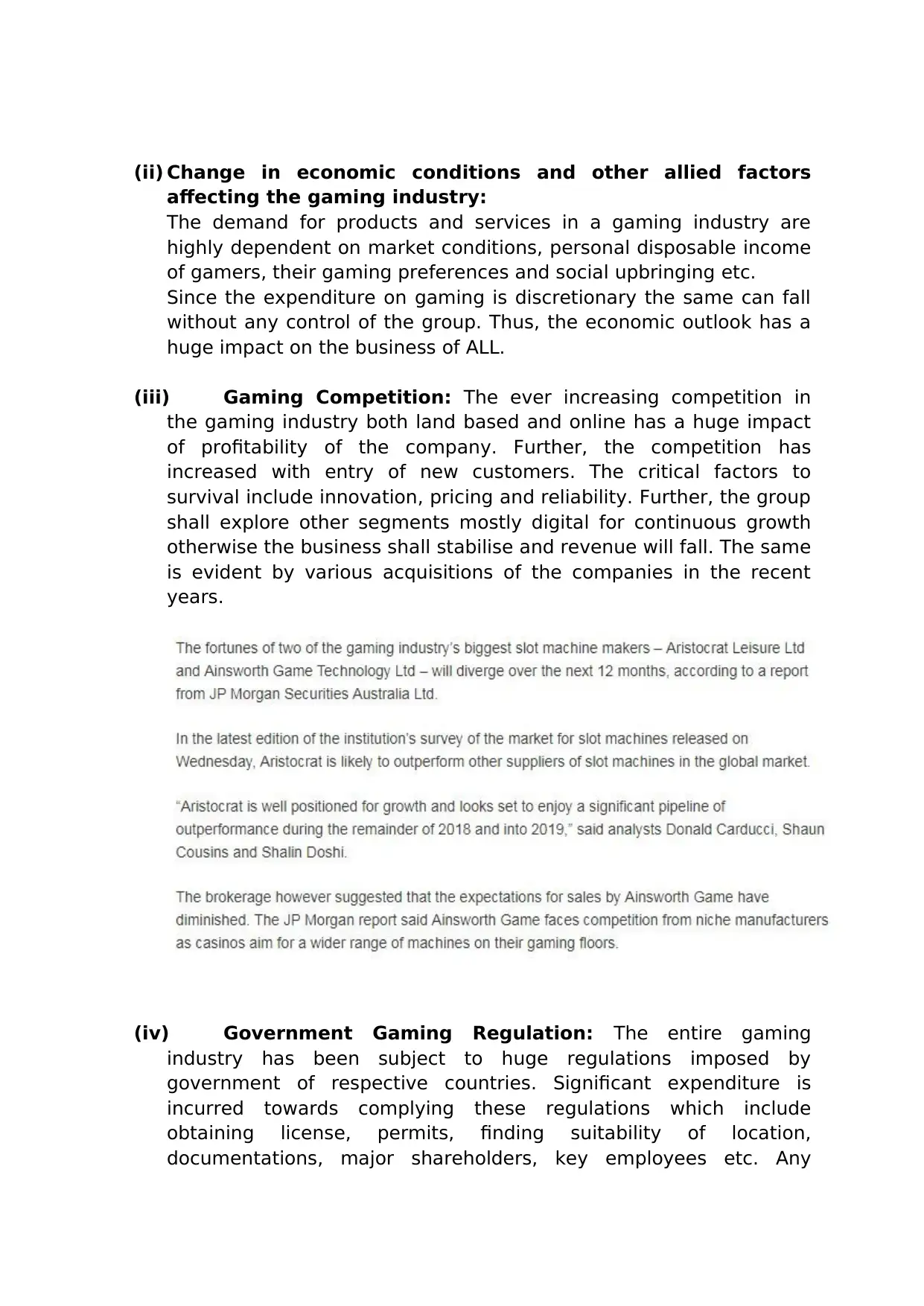
(ii) Change in economic conditions and other allied factors
affecting the gaming industry:
The demand for products and services in a gaming industry are
highly dependent on market conditions, personal disposable income
of gamers, their gaming preferences and social upbringing etc.
Since the expenditure on gaming is discretionary the same can fall
without any control of the group. Thus, the economic outlook has a
huge impact on the business of ALL.
(iii) Gaming Competition: The ever increasing competition in
the gaming industry both land based and online has a huge impact
of profitability of the company. Further, the competition has
increased with entry of new customers. The critical factors to
survival include innovation, pricing and reliability. Further, the group
shall explore other segments mostly digital for continuous growth
otherwise the business shall stabilise and revenue will fall. The same
is evident by various acquisitions of the companies in the recent
years.
(iv) Government Gaming Regulation: The entire gaming
industry has been subject to huge regulations imposed by
government of respective countries. Significant expenditure is
incurred towards complying these regulations which include
obtaining license, permits, finding suitability of location,
documentations, major shareholders, key employees etc. Any
affecting the gaming industry:
The demand for products and services in a gaming industry are
highly dependent on market conditions, personal disposable income
of gamers, their gaming preferences and social upbringing etc.
Since the expenditure on gaming is discretionary the same can fall
without any control of the group. Thus, the economic outlook has a
huge impact on the business of ALL.
(iii) Gaming Competition: The ever increasing competition in
the gaming industry both land based and online has a huge impact
of profitability of the company. Further, the competition has
increased with entry of new customers. The critical factors to
survival include innovation, pricing and reliability. Further, the group
shall explore other segments mostly digital for continuous growth
otherwise the business shall stabilise and revenue will fall. The same
is evident by various acquisitions of the companies in the recent
years.
(iv) Government Gaming Regulation: The entire gaming
industry has been subject to huge regulations imposed by
government of respective countries. Significant expenditure is
incurred towards complying these regulations which include
obtaining license, permits, finding suitability of location,
documentations, major shareholders, key employees etc. Any
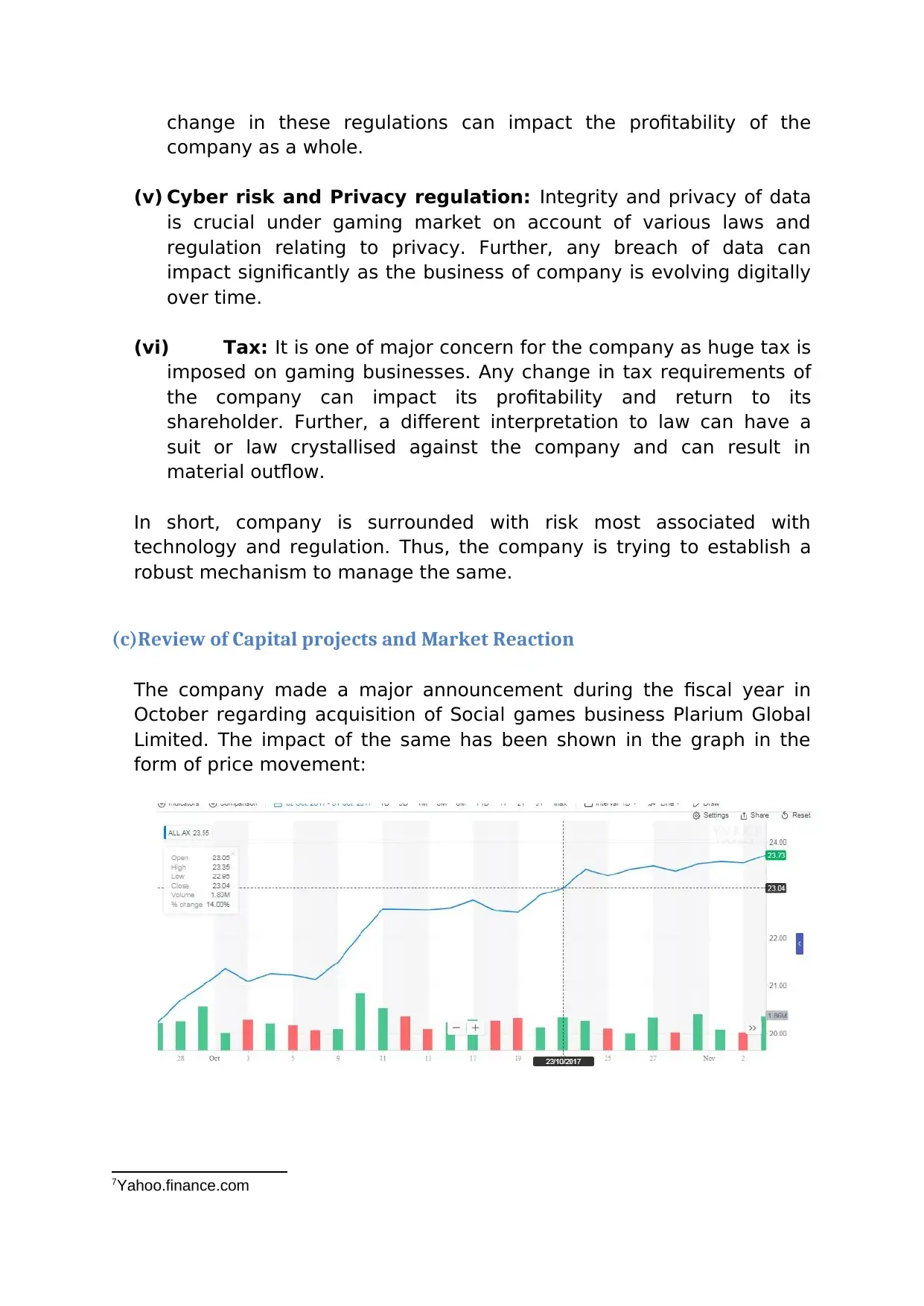
change in these regulations can impact the profitability of the
company as a whole.
(v) Cyber risk and Privacy regulation: Integrity and privacy of data
is crucial under gaming market on account of various laws and
regulation relating to privacy. Further, any breach of data can
impact significantly as the business of company is evolving digitally
over time.
(vi) Tax: It is one of major concern for the company as huge tax is
imposed on gaming businesses. Any change in tax requirements of
the company can impact its profitability and return to its
shareholder. Further, a different interpretation to law can have a
suit or law crystallised against the company and can result in
material outflow.
In short, company is surrounded with risk most associated with
technology and regulation. Thus, the company is trying to establish a
robust mechanism to manage the same.
(c)Review of Capital projects and Market Reaction
The company made a major announcement during the fiscal year in
October regarding acquisition of Social games business Plarium Global
Limited. The impact of the same has been shown in the graph in the
form of price movement:
7Yahoo.finance.com
company as a whole.
(v) Cyber risk and Privacy regulation: Integrity and privacy of data
is crucial under gaming market on account of various laws and
regulation relating to privacy. Further, any breach of data can
impact significantly as the business of company is evolving digitally
over time.
(vi) Tax: It is one of major concern for the company as huge tax is
imposed on gaming businesses. Any change in tax requirements of
the company can impact its profitability and return to its
shareholder. Further, a different interpretation to law can have a
suit or law crystallised against the company and can result in
material outflow.
In short, company is surrounded with risk most associated with
technology and regulation. Thus, the company is trying to establish a
robust mechanism to manage the same.
(c)Review of Capital projects and Market Reaction
The company made a major announcement during the fiscal year in
October regarding acquisition of Social games business Plarium Global
Limited. The impact of the same has been shown in the graph in the
form of price movement:
7Yahoo.finance.com
⊘ This is a preview!⊘
Do you want full access?
Subscribe today to unlock all pages.

Trusted by 1+ million students worldwide
1 out of 22
Related Documents
Your All-in-One AI-Powered Toolkit for Academic Success.
+13062052269
info@desklib.com
Available 24*7 on WhatsApp / Email
![[object Object]](/_next/static/media/star-bottom.7253800d.svg)
Unlock your academic potential
Copyright © 2020–2026 A2Z Services. All Rights Reserved. Developed and managed by ZUCOL.





